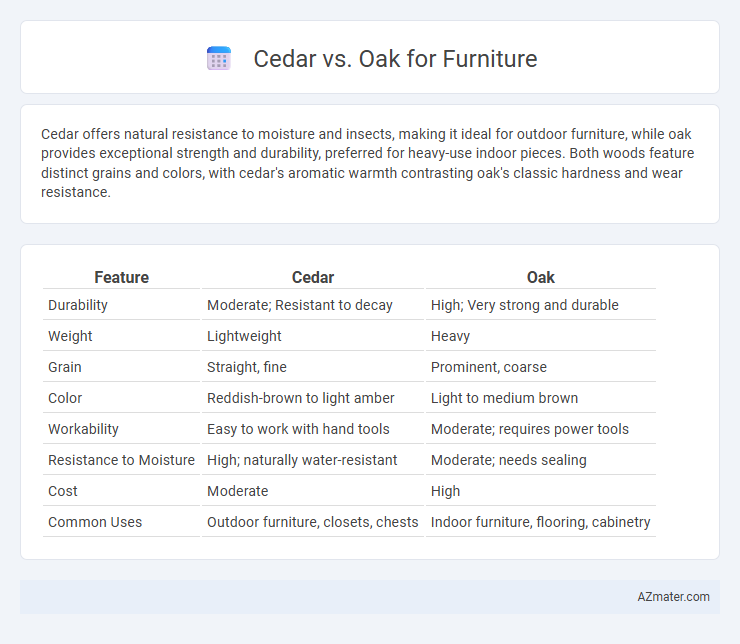Cedar offers natural resistance to moisture and insects, making it ideal for outdoor furniture, while oak provides exceptional strength and durability, preferred for heavy-use indoor pieces. Both woods feature distinct grains and colors, with cedar's aromatic warmth contrasting oak's classic hardness and wear resistance.
Table of Comparison
| Feature | Cedar | Oak |
|---|---|---|
| Durability | Moderate; Resistant to decay | High; Very strong and durable |
| Weight | Lightweight | Heavy |
| Grain | Straight, fine | Prominent, coarse |
| Color | Reddish-brown to light amber | Light to medium brown |
| Workability | Easy to work with hand tools | Moderate; requires power tools |
| Resistance to Moisture | High; naturally water-resistant | Moderate; needs sealing |
| Cost | Moderate | High |
| Common Uses | Outdoor furniture, closets, chests | Indoor furniture, flooring, cabinetry |
Introduction to Cedar and Oak Furniture
Cedar furniture is prized for its natural resistance to moisture, decay, and insect damage, making it ideal for outdoor and humid environments. Oak furniture, known for its strength and durability, features a prominent grain pattern and is a popular choice for traditional and hardwood furniture pieces. Both woods offer distinctive aesthetics and functional benefits that cater to different interior design styles and durability needs.
Wood Grain and Appearance Comparison
Cedar features a straight and uniform wood grain with a natural reddish hue that darkens over time, providing a warm and rustic appearance ideal for outdoor furniture. Oak displays a distinctive, prominent grain pattern with swirling and varied textures, often lighter in color and lending a classic and elegant look to indoor furniture pieces. Both woods offer unique aesthetic qualities, with cedar emphasizing natural charm and oak showcasing bold, intricate grain details.
Durability and Strength: Cedar vs Oak
Oak is renowned for its superior durability and strength, making it ideal for heavy-use furniture that requires long-lasting resilience and resistance to dents and scratches. Cedar, while softer and less dense, offers moderate durability with natural resistance to decay and insects, making it suitable for outdoor or less frequently used furniture. The dense grain structure of oak ensures structural integrity over time, whereas cedar's lightweight nature provides easier handling but reduced load-bearing capacity.
Resistance to Decay and Insects
Cedar is renowned for its natural resistance to decay and insects due to the presence of aromatic oils that repel pests and prevent fungal growth, making it ideal for outdoor and damp environments. Oak, while strong and durable, is more susceptible to insect infestation and rot unless properly treated, requiring regular maintenance to enhance its longevity. The inherent decay resistance of cedar often leads to longer-lasting furniture when exposed to moisture or insect-prone conditions compared to oak.
Weight and Workability of Cedar and Oak
Cedar is significantly lighter than oak, making it easier to handle and transport for furniture projects. Its softness allows for smooth cutting and shaping, enhancing workability compared to the dense and harder oak. Oak's weight contributes to its durability but requires more effort and sharper tools during crafting and finishing processes.
Cost and Availability of Cedar vs Oak
Cedar furniture generally costs less than oak due to its faster growth rate and greater availability in North American forests, making it a budget-friendly option. Oak is more expensive because it is a hardwood known for durability and a slower growth cycle, which limits supply and drives up price. Availability of cedar is higher in regions with abundant coniferous trees, while oak is dominant in temperate zones, affecting market prices and accessibility.
Environmental Impact and Sustainability
Cedar furniture is favored for its natural resistance to decay and insects, reducing the need for chemical treatments that harm the environment, while oak requires more intensive processing and chemical use. Cedar trees grow faster and are more renewable compared to slow-growing oak, making cedar a more sustainable choice in terms of forest regeneration. Oak's durability can lead to longer-lasting furniture, but its harvesting often contributes to deforestation and habitat disruption, impacting biodiversity.
Best Uses for Cedar Furniture
Cedar furniture is ideal for outdoor settings due to its natural resistance to moisture, decay, and insect damage, making it perfect for garden benches, patio sets, and porch swings. Its aromatic oils provide a pleasant scent and repel moths, enhancing storage chests and wardrobes. Compared to oak, cedar requires less maintenance in humid environments and offers lightweight durability suited for casual, rustic furniture pieces.
Ideal Applications for Oak Furniture
Oak furniture is highly prized for its durability and resistance to wear, making it ideal for heavy-use items such as dining tables, chairs, and cabinets. Its dense grain structure and natural hardness provide excellent support and longevity for both traditional and contemporary furniture designs. Oak's ability to accept stains and finishes well enhances its versatility, allowing customization to suit various interior decor styles.
Cedar vs Oak: Which Is Right for Your Home?
Cedar offers natural resistance to moisture, insects, and decay, making it ideal for outdoor furniture or humid environments, while oak is renowned for its strength, durability, and classic grain patterns, perfect for high-traffic indoor pieces like dining tables. Cedar's lighter weight and aromatic properties create a warm, pleasant ambiance, whereas oak's hardness provides superior resistance to dents and scratches. Choosing between cedar and oak depends on the furniture's location, desired aesthetic, and long-term durability needs in your home.

Infographic: Cedar vs Oak for Furniture
 azmater.com
azmater.com